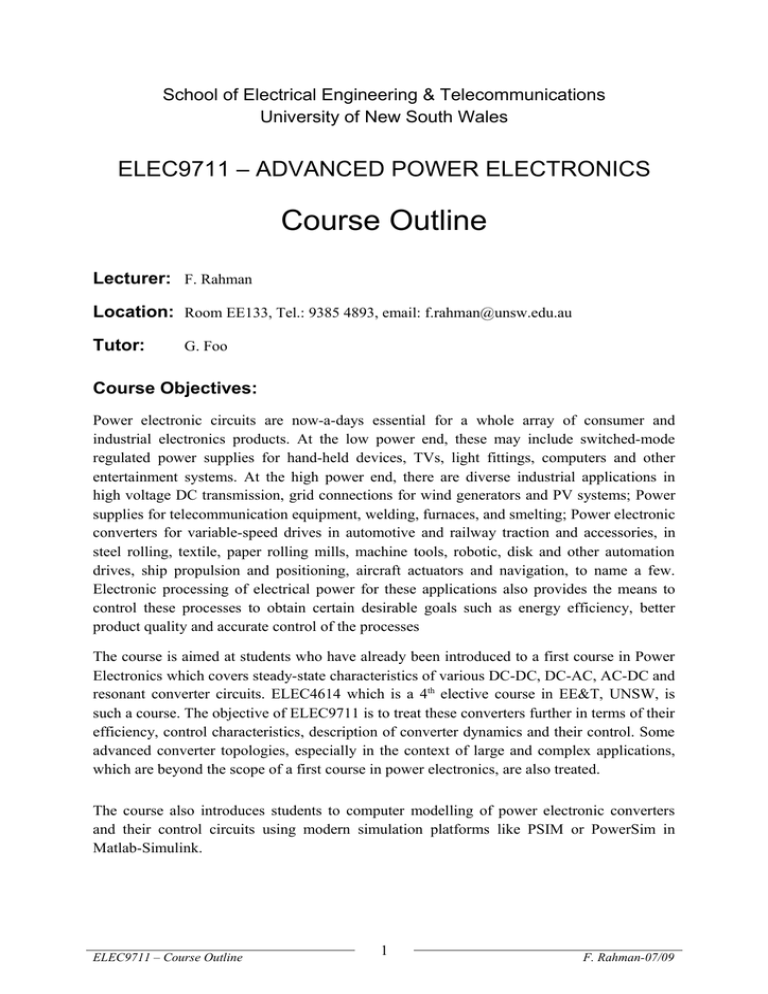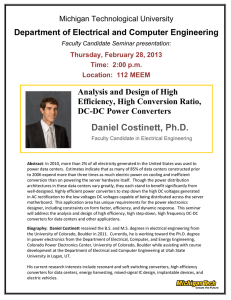Course Outline - Current Students
advertisement

School of Electrical Engineering & Telecommunications University of New South Wales ELEC9711 – ADVANCED POWER ELECTRONICS Course Outline Lecturer: F. Rahman Location: Room EE133, Tel.: 9385 4893, email: f.rahman@unsw.edu.au Tutor: G. Foo Course Objectives: Power electronic circuits are now-a-days essential for a whole array of consumer and industrial electronics products. At the low power end, these may include switched-mode regulated power supplies for hand-held devices, TVs, light fittings, computers and other entertainment systems. At the high power end, there are diverse industrial applications in high voltage DC transmission, grid connections for wind generators and PV systems; Power supplies for telecommunication equipment, welding, furnaces, and smelting; Power electronic converters for variable-speed drives in automotive and railway traction and accessories, in steel rolling, textile, paper rolling mills, machine tools, robotic, disk and other automation drives, ship propulsion and positioning, aircraft actuators and navigation, to name a few. Electronic processing of electrical power for these applications also provides the means to control these processes to obtain certain desirable goals such as energy efficiency, better product quality and accurate control of the processes The course is aimed at students who have already been introduced to a first course in Power Electronics which covers steady-state characteristics of various DC-DC, DC-AC, AC-DC and resonant converter circuits. ELEC4614 which is a 4th elective course in EE&T, UNSW, is such a course. The objective of ELEC9711 is to treat these converters further in terms of their efficiency, control characteristics, description of converter dynamics and their control. Some advanced converter topologies, especially in the context of large and complex applications, which are beyond the scope of a first course in power electronics, are also treated. The course also introduces students to computer modelling of power electronic converters and their control circuits using modern simulation platforms like PSIM or PowerSim in Matlab-Simulink. ELEC9711 – Course Outline 1 F. Rahman-07/09 Opportunities: The course is intended for students who may want to further their knowledge on the analysis, analysis, design, control, efficiency analysis and switching techniques of power electronic converter circuits. It should be relevant to engineers who may be involved in the design, selection and maintenance of electronic power converters applied in the form of AC and DC power supplies in appliances, in utility applications for grid connection of renewable power sources, DC transmission and active power filter, in traction systems such automotives and rail transport, in industrial automation equipment such as for motor drives, ship propulsion and so on. Brief Syllabus: UOC6 HPW3 The topics to be covered in this course will include: Advanced topics in DC-DC converters, inverters, AC-DC converters and AC-AC converters; resonant converters; dynamic representation of DC-DC converters, control loops design, converter circuit and system modelling using PSIM or other platforms, device selection and their modeling, thermal design, gate drive circuit design, magnetic core and other component selection and design, case studies of converter system designs. Course Content______ Hours ______ DC-DC converters & power supplies 1. Review of assumed knowledge and switching devices; 4 Review of steady-state characteristics of DC-DC converter circuits. SEPIC and Cuk converters; PSIM models. 2. Analysis of non-ideal switches and circuit elements in 4 DC-DC converters,efficiency calculation, voltage transfer characteristics with continuous and discontinuous inductor current. PSIM models 3. Representation of dynamics of buck, boost and forward 4 converters; state-space averaging, PWM controller; control loop design, voltage control, current mode control; Limiting of inrush current; Inductor and capacitor components. DC-AC Inverters ELEC9711 – Course Outline 2 F. Rahman-07/09 4. Review of assumed knowledge on DC-AC inverter circuits; 6 advanced modulation techniques, SVM; Compensation for for dead time and device voltage drops. PSIM Models; Current source inverters, multi-level and Z-source inverters. Rectifier/inverter with bi-directional power flow. 5. Resonant converters Zero-current switched (ZCS) DC-DC converter Zero-voltage switched (ZVS) DC-DC converter Series-resonant converter/inverter Parallel-resonant converter/inverter Series-parallel resonant converter Resonant DC-link inverter/converter 6 6. AC-DC and AC-AC converters Effect of source inductance in diode rectifier circuits Effect of source inductance in controlled rectifier circuits Single- and three-phase Cycloconverter circuits Matrix converter 6 ______________________________________________________________________ Total hours 30 Lecture Notes Lecture notes written by the lecturer for each section will be available from the course webpage. These will be based on the following text books and other reference material which will be cited within the lecture notes. All lecture notes, assignments, tutorial and technical report topics for this course can be downloaded on the school webpage, via Current Students → Study Notes → Lecture Notes. You may have to use username: (your student number) and password: ee&tview in order to access these documents. Students will be expected to bring the printed lecture notes and tutorial sheets into the lecture/tutorial room. Textbook: 1. N. Mohan, T. M. Undeland & W. P. Robins, “Power Electronics; Converters, Applications and Design”, John Wiley, Second Edition, 1995, New York. ELEC9711 – Course Outline 3 F. Rahman-07/09 References: 2. J. G. Kassakian, M.F. Schlecht & G.C. Verghese, “Principles of Power Electronics”, Addison Wesley, 1991. 3. R. W. Erickson, "Fundamentals of Power Electronics”, Kluwer Academic Publications, 1997. 4. D. W. Hart, “Introduction to Power Electronics”, Prentice Hall International, 1997. ELEC9711 – Course Outline 4 F. Rahman-07/09 Assessment: Students will be assessed according to the following scheme: Mid-session Test 15% of total Hand-in questions and assignments 10% of total Technical reports 15% of total Final Examination 60% of total The final examination will be worth 60 marks. Any four, each of equal mark, out of the six questions set in the final examination may be answered. Tutorials: Lectures will be supplemented with problem solving tutorial sessions. Five to six tutorial sheets may be expected These problem-solving sessions will be on most recently covered topics. Additionally, PSIM sessions will be arranged in room EE214. Students will be expected to participate vigorously during these sessions, in the form of questions, suggested solutions and methods. Participation by students and the tutor should be viewed as desirable aspects of these sessions. ELEC9711 – Course Outline 5 F. Rahman-07/09


